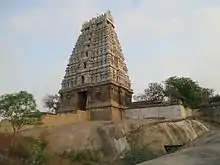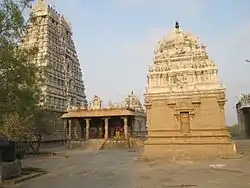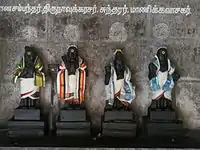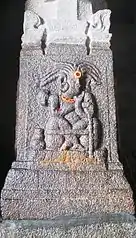Atulya Nadheswarar Temple
Atulya Nadheswarar Temple (அதுல்யநாதேஸ்வரர் கோயில்)[1] is a Hindu temple dedicated to the deity Shiva, located in Arakandanallur, a town panchayat in Viluppuram district in the South Indian state of Tamil Nadu. Shiva is worshipped as Atulya Nadheswarar, and is represented by the lingam. His consort Parvati is depicted as Azhagiya Ponnazhagi. The presiding deity is revered in the 7th century Tamil Saiva canonical work, the Tevaram, written by Tamil saint poets known as the Nayanars and classified as Paadal Petra Sthalam.
| Atulya Nadheswarar Temple | |
|---|---|
 | |
| Religion | |
| Affiliation | Hinduism |
| District | Viluppuram |
| Deity | Atulya Nadheswarar(Shiva) |
| Location | |
| State | Tamil Nadu |
| Country | India |
 Location in Tamil Nadu | |
| Geographic coordinates | 11°58′28″N 79°13′13″E |
| Architecture | |
| Type | Dravidian architecture |
The temple complex covers two acres, built on a granite hill and it houses a seven tier gateway tower known as gopurams. The temple has a number of shrines, with those of Atulya Nadheswarar and his consort Azhagiya Ponnazhagi being the most prominent.
The temple has four daily rituals at various times from 7:00 a.m. to 8:30 p.m., and four yearly festivals on its calendar. The Brahmotsavam festival celebrated during Vaikasi (May - June) is the most prominent festival.
The original complex is believed to have been built by Pallavas, with later expansion by Cholas, while the present masonry structure was built during the Vijayanagara Empire during the 16th century. There are three rock-cut caves from the Pallava regime during the 10th century. In modern times, the temple is maintained and administered by the Hindu Religious and Charitable Endowments Department of the Government of Tamil Nadu.
Legend

As per Hindu legend, Vishnu wanted to propitiate the sins caused by slaying Mahabali during Vamana avatar. He prayed Shiva for the same at various Shiva temples. His sins were cleared while worshipping Shiva. There is an image of Vishnu in a sculpture showing the legend. As per another legend, Sambandar, the 7th century Saiva saint Nayanmar, visited the place and sung praises of Atulya Natheswarar. The temple was locked down earlier by Jain monks and was believed to have been brought to worship practises after Sambandar. He was planning to go to Tiruvannamalai, but was stopped by a divine force. He set up Annamalaiyar as Lingam in this place and started worshiping. It is believed that Samndar's foot steps are seen at the place and the Annamalaiyar Temple at Tiruvannamali can be viewed from the point.[2] Arai indicates rock while ani indicates beauty - since Shiva appears beautifully over the rock, the presiding deity of the temple is called Araiyanitheeswarar, which is Sankritised version of Atulya Nadheswarar.[3]
History
The original complex is believed to have been built by Pallavas, with later expansion by Cholas, while the present masonry structure was built during the Vijayanagara Empire during the 16th century. There are three rock-cut caves from the Pallava regime during the 10th century. The current Draupadi Amman shrine is believed to have been a Murugan temple.[2] There are inscriptions from lot of medieval and later Chola emperors like Rajaraja Chola I (985–1014), Kulothunga Chola I (1070–1120), Vikrama Chola (1118–1135), Kulothunga Chola II (1133–1150), Rajadhiraja Chola II (1166–1178), Kulothunga Chola III (1178–1218), Rajaraja Chola III (1216–1256) and Rajendra Chola III (1246–1279). There are inscriptions from Pandya kings like Maravarman Sundara Pandyan (1216–1238) and Maarvarman Vikrama Pandiyan. The contributions of the kings of the Vijayanagara Empire like Krishna Deva Raya (1509–1529), Sadasiva Raya (1542–1570) and Kampanna Udayar are also found in the inscriptions. There are also inscriptions from the Sambuvaraya period, during the regime of Sagaloga Chadravarathi Rajanarayana Sambuvarayar. In all, there are a total of 96 inscriptions in the temple compiled in the Annual Reports on South Indian Epigraphy for the year 1902 in numbers 386–391, year 1905 number 26 and year 1935 number 111–195.[4][5] Rajanarayana Sambuvaraya was a chieftain of Medieval Cholas whose contributions are documented in his inscriptions across various temples in modern-day Villupuram, Cuddalore, Tiruvannamalai and Kanchipuram districts and also in his Sanskrit work Madhuravijayam. He repaired, revived the services and inaugurated festivals of the temple.[6] In modern times, the temple is maintained and administered by the Hindu Religious and Charitable Endowments Department of the Government of Tamil Nadu.[2]
Architecture

This temple is situated in Arakandanallur, a town panchayat in Viluppuram district, located 2 km from Tirukoilur on the Tirukoilur - Viluppuram highway. The temple is located on the northern banks of Cheyyar River. The nearest railway station is at Tirukoyilur and the nearest airport is Chennai International Airport. The Shiva temple at Arkandanallur is spread over an area of 2 acres (8,100 m2). The main rajagopuram is on the West side with seven tiers and pierces the large rectangular granite walls. The temple tank, Indra Theertha, is located 1 km (0.62 mi) from the temple. The temple is built on a granite hill and there are two corridors inside the temple. The main shrine accommodates the image of Shiva known as Atulya Nadheswarar in the form of Lingam. There is a separate shrine for Azhagiya Ponnazhagi to the right of Atulya Nadheswarar's shrine in the second precinct. The first precinct on the four sides of the sanctum sanctorum are decorated with the images of Nayanmars, Navagrahas, Bhairava, Murugan Sannadhi in the northwest and Durga Sannadhi on the northeast.[2] The two Nandis in the temple are called Pradosha Nandi and Adigara Nandi - there are placed slightly off axis to the sanctum. The Saniswarar image in the temple is depicted with him having a foot over his vehicle mount crow. The Murugan image is depicted with a single head and six hands. The Shrine of Annamalaiyar is located South East of the central shrine in the second precinct.[3] The rock-cut temples from the Pallava period are centred to border around the Pennar river, forming the southern extremity of the series.[7] The Sapthamatrika images are present in the first precinct and are depicted flanking on the sides of Shiva or Vinayaga, attributing to their male counterparts.[8]
Religious importance
It is one of the shrines of the 275 Paadal Petra Sthalams - Shiva Sthalams glorified in the early medieval Tevaram poems by Tamil Saivite Nayanar Thirugnana Sambanthar. As the temple is revered in Tevaram, it is classified as Paadal Petra Sthalam, one of the 275 temples that find mention in the Saiva canon. Sambandar refers this place as Araiyinallur, which later went on to become Arkandanallur.[9] To ease the worship of Sambandar, the Nandi, the sacred bull of Shiva, tilted a little. The two Nandis in the temple are placed slightly off axis to the sanctum to indicate the legend. Ramalinga Swamigal has stayed in this place and sung praises of Atulya Nadeswarar. The Hindu saint Ramana Maharishi is believed to have stayed in the caves in the temple and was led to Tiruvannamalai.[3][10] As per Periya Puranam, the hagiography depicting the life of the 63 Nayanmars, Sambandar visited the place before moving to Tiruvannamalai.[4]
Festivals

The temple priests perform the puja (rituals) during festivals and on a daily basis. The temple rituals are performed four times a day; Kalasanthi at 7:00 a.m., Irandam Kalm at 9:00 a.m., Sayarakshai at 6:00 p.m, and Arthajamam at 8:00 p.m. Each ritual comprises four steps: abhisheka (sacred bath), alangaram (decoration), naivethanam (food offering) and deepa aradanai (waving of lamps) for Atulya Nadheswarar and Azhagiya Ponnazhagi. There are weekly rituals like somavaram (Monday) and sukravaram (Friday), fortnightly rituals like pradosham, and monthly festivals like amavasai (new moon day), kiruthigai, pournami (full moon day) and sathurthi. Other festivals include Vinayaka Chaturthi, Aadi Pooram, Navaratri, Aippasi Pournami, Skanda Sashti, Kartikai Deepam, Arudra Darisanam, Tai Poosam, Maasi Magam, Panguni Uththiram and Vaikasi Visakam. The major festival of the temple is the Brahmotsavam celebrated during the Tamil month of Vaikasi (May - June), when special worship practises are followed.[2][3]
References
- ta:அறகண்டநல்லூர் அதுல்யநாதேஸ்வரர் கோயில்
- R., Dr. Vijayalakshmy (2001). An introduction to religion and Philosophy - Tévarám and Tivviyappirapantam (1st ed.). Chennai: International Institute of Tamil Studies. pp. 155–6.
- "Sri Atulya Nadeswarar temple". Dinamalar. 2014. Retrieved 24 November 2015.
- "Arayaninallur". Thevaaram.org. 2011. Retrieved 14 March 2016.
- S.R., Balasubrahmanyan; B., Natarjan; Ramachandran, Balasubrahmanyan (1979). Later Chola Temples: Kulottunga I to Rajendra III (A.D. 1070-1280), Parts 1070-1280. Mudgula Trust. p. 95.
- A., Krishnaswami (1957). "The Sambuvarayas of Padaividu their roles in South". Proceedings of the Indian History Congress. 20: 190–1. JSTOR 44304461.
- Verma, Archana (2012). Temple Imagery from Early Mediaeval Peninsular India. Ashgate Publishing, Ltd. p. 32. ISBN 9781409430292.
- Orr, Leslie C. (March 2005). "Identity and Divinity: Boundary-Crossing Goddesses in Medieval South India". Journal of the American Academy of Religion. Oxford University Press. 73 (1): 24. doi:10.1093/jaarel/lfi003 – via JSTOR.
- K.M., Venkataramaiah; International School of Dravidian Linguistics (1996). A handbook of Tamil Nadu. International School of Dravidian Linguistics. p. 367. ISBN 9788185692203.
- Taleyarkhan, Feroza (1970). Sages, Saints, and Arunachala Ramana. Orient Longmans. p. 88.
External links
| Wikimedia Commons has media related to Atulya Nadheswarar Temple. |


